Choosing Kitchen Countertops
Kitchen countertops are hard-working surfaces that more or less act as the kitchen's 'workbench'. However any functional similarity with their garage counterparts ends when you consider the wide range of material choices that are available.
There's probably no other product in the house, other than flooring perhaps, that's available in such a wide assortment of materials and styles.
But that wasn't always the case. Years ago you had only a few choices for countertop surfaces. That's all changed because today you have a vast array of materials to suit your style and taste. Products range anywhere from glass to stone and recycled paper to concrete.
Don't forget that your counters present a pretty large surface area too and as such, give you a large palette on which to influence the décor of your kitchen overall. The key is matching a material and style you like to the kind of lifestyle you live.
In other words, good looks are important but don't make choices at the expense of durability. Some surfaces are better than others at standing up to the rigors of the kitchen (and some kitchen environments are harsher than others).
The best choice is one that will meet your performance expectations, offers great aesthetics and leaves some money in the bank account.
So where do you begin? Let's first start out by doing a little self-assessment on what your expectations are. From there you can check out what's available and the highs and lows of each material to help determine which option might be a good fit.
What Should I Know Before Choosing Kitchen Counter Surfaces?
Choosing your countertops is one of the fun parts of a designing your kitchen. But before letting emotion completely take over, identify or write down your goals on what it is you want to achieve with your new kitchen or remodel. This will help you identify specific types that fit your objectives.
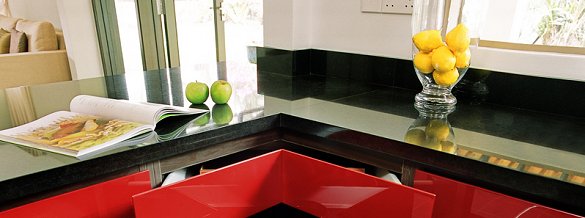
Despite the wide range of choices available, each has their own distinct advantages and disadvantages. Take time to ask yourself the following questions to help focus in on a short list of options:
- Are you going strictly for a look and feel that you have your heart set on, regardless of any other decision factors?
Giving your kitchen that "wow" factor is certainly a thrill and if your countertops are what make your kitchen pop, then go for it. However don't overlook practicality and don't think that your countertops will somehow be immune to the "stuff" that really happens in the everyday life of a kitchen. Be realistic. - Are you looking for practicality and something that is easily maintainable and affordable?
Laminate is still one of the best options for an affordable and easily maintained surface. Most varieties are pretty inexpensive, though some of the more premium laminate products aren't as cheap. A good hard granite (preferably a darker color) is also a durable choice and some non-premium colors can be had relatively cheaply, but it will still be more expensive than laminate. - How do you intend on using your kitchen countertops? Do you do a lot of cooking and food preparation or will your countertops see less use?
Hard-working kitchens (you cook a lot, have kids, a clumsy spouse, etc.) need a work top that will last and still look good even after you dish out the punishment. Look for materials that will last and won't need so much TLC. Laminate, granite, and engineered stone (quartz) are good choices here. - What kind of long term durability are you looking for? Do you want your kitchen countertops to look the same 10 years from now, with no visible signs of aging, wear or patina?
Some surfaces like metal, wood, and even solid surface will show signs of use over time whether they be changes in color or dulling due to scratches. Stone and quartz surfaces along with tile and lava stone that have very hard surfaces will be your best shot at keeping the look over time. Laminate is another contender for a work top that maintains it's looks long-term (provided you choose a timeless color/pattern). - What level of maintenance are you willing to sign up for?
Some counter surfaces take less effort to maintain than others. Laminate (is there a recurring theme here. . .?) doesn't require much else than a wipe down to keep it looking nice. Quartz/engineered stone, solid surface and lava stone fall into this category too. Others, like some natural stone counters and some woods (depending on surface treatment) require periodic sealing and upkeep. Be realistic about whether you're up for the added care (or will live with the ramifications). - Do you want surfacing that is more environmentally-friendly?
There are choices you can make if you prefer countertops made from sustainable and/or recycled materials for a softer impact on the environment. If that's important to you then the composite/recycled category is one to take a closer look at. Wood, particularly reclaimed wood, is another alternative for an eco-friendly counter.
Once you've put some thought into these questions you should be better equipped to sort through the various choices available to you and narrow down your options. But before you do that here are a few more points to keep in mind before you make your ultimate decision:
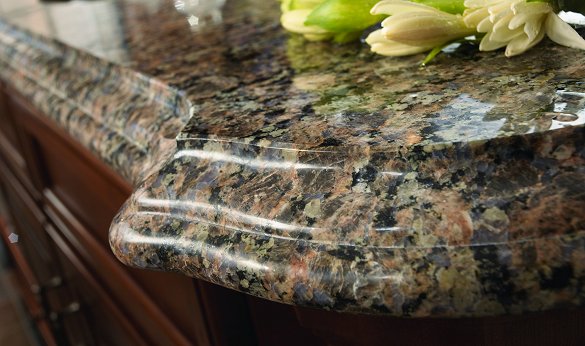 Sensa Granite by Cosentino - Photo Courtesy of Cosentino
Sensa Granite by Cosentino - Photo Courtesy of Cosentino
- Some types of stone countertops are naturally porous and will need to be sealed in order to maintain their stain resistance. Stone is also heavy so your cabinets and supporting structure should be designed to handle the weight.
- Edge treatments play a large role in the overall cost of your countertops. Fancy or intricate edges typically require more time and effort to produce which drives up the cost, particularly with materials that are harder to work and cut like stone. Think about going with a more standard or less elaborate edge. It might allow you to get the countertop of your choice while staying within your budget
- Laminate counters are durable, affordable and can be found in a multitude of different colors and patterns, some that mimic the look of natural stone. There are also edge treatments such as a wood edge or beveled edge that virtually eliminate the dark line typically seen with this type of countertop surface.
- No material is perfect although some come close from a durability and minimal-maintenance perspective. But don't think that they're indestructible. Understanding that a little care and maintenance is required should help avoid disappointment down the road.
- Countertop surfaces vary in their strengths and weaknesses so take advantage of that. Don't be afraid to mix up materials within your kitchen. Use butcher block for a dedicated cutting area and a more 'delicate' choice for less-used areas you'd like to show off.
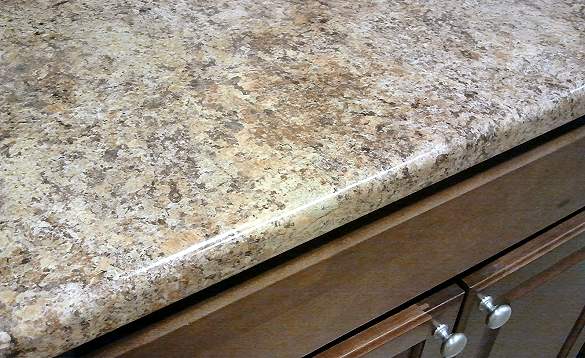
Types Of Kitchen Countertops
So here are your choices for countertop surfaces. Take some time to get familiar with them, dream a little, and then take a look at the pros/cons to get a better feel for whether they fit your requirements.
Keep in mind that the choices listed here are primarily categories. Within each category there are various brands and products that are available. For example, there are multiple solid surface manufacturers, each with their own design formulas, styles and innovations.
Any product types that show up as blue hyperlinks will link to another page on this site that goes into more depth.
Laminate
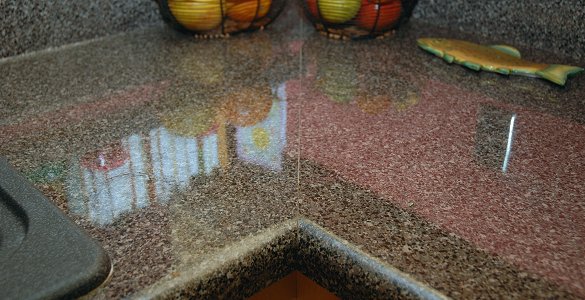
Well known by trade names such as Formica®, laminate countertops have stood the test of time. New innovations make for a broad range of colors and patterns and more recently, the addition of textures.
| Pros | Cons |
|
Affordable Easily maintained Almost limitless range of colors/patterns |
Edges and seams visible (on many varieties but not all) Not heat tolerant Can scratch and chip Chips not easily repaired and repairs (such as colored pastes) are still visible after repair |
Solid Surface
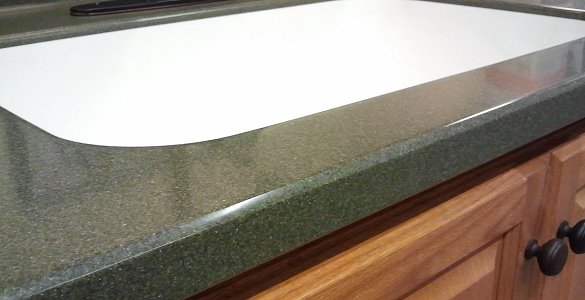
Solid surface is basically a plastic but that's where the blandness ends. Many styles and colors are available and the seamless characteristics work well for expansive countertops and integral sinks.
| Pros | Cons |
|
Renewable (cuts and scratches can be blended out) Allows for the use of integrated sinks (no visible seams between sink and countertop) No visible seams which is advantageous on large countertop designs Non-porous Many patterns and colors available, some which (try to) resemble natural stone |
Softer and easier to scratch than stone or other harder surfaces Not heat resistant Relatively higher cost among the countertop surfaces Requires professional fabrication/installation in most cases including repairs Glossier surfaces can dull over time from scuffs and small scratches |
Natural Stone
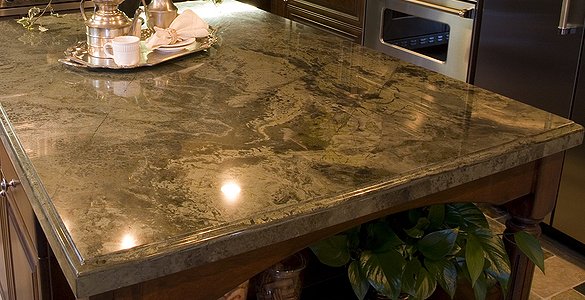
Granite, slate, soapstone, marble, gemstone, the list goes on. Natural stone has an inherent beauty but there is some maintenance involved in keeping it 'healthy', depending on the type of stone you buy. Stone countertops are sometimes perceived to be expensive and in some cases this can be true. But there are types of granite that can be had for very affordable prices.
| Pros | Cons |
|
Natural beauty that's not really duplicated with man-made products Lasts virtually forever if maintained More heat tolerant than other countertop surfaces |
Some stone requires maintenance such as sealing to prevent stains Porous - some granites and marble can stain without proper protection Can chip and crack Can be expensive depending on the stone type, color, and rarity however some granites have become very affordable due to more cost effective processing techniques Speculation exists about radon emissions from some types of granite (see this article for more information) |
Engineered Stone
Engineered stone combines the properties and benefits of real stone (beauty, hardness, durability) with other ingredients to make a product that eliminates the Achilles' heel of stone, which is mainly it's porosity and maintenance requirements. Quartz countertops make up a large part of the engineered stone category though there are other types of stone that are used. Some of the colors and patterns do a pretty good job mimicking the look of natural stone.
| Pros | Cons |
|
The look mimics some granite and other natural stone Durable as stone but non-porous and stain resistant so it doesn't require sealing Can be offered in colors not found with natural stone Widely available |
Can be expensive and/or on par with some natural stone prices depending on color choice and edge profiles Not completely immune to scratching (due to the softer resin binder that holds the stone matrix together) |
Wood
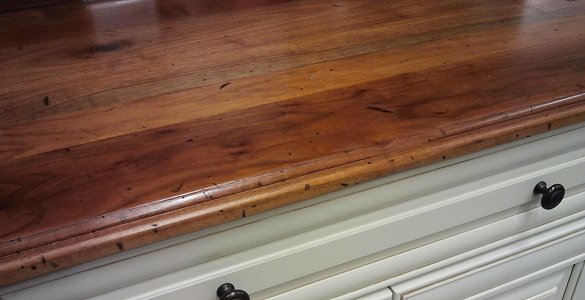
Wood countertops no longer mean just butcherblock countertops. There are plenty of style options involving wood species and edge treatments and even the option of using reclaimed wood for those who want an eco-friendly countertop. There are lots of wood countertop sources too so finding a supplier shouldn't be a problem. There is some maintenance involved to keep them looking good however so it's worth investigating further to know if it's right for your kitchen.
| Pros | Cons |
|
Unique aesthetic appeal Offers a warmer surface than stone or engineered stone Butcher block style provides good cutting surface |
Requires sealing and periodic resealing depending on the application Susceptible to water damage if not properly treated/sealed Generally a softer material and can dent and will scratch and show cut marks |
Bamboo
Photo Courtesy of Totally Bamboo
Bamboo is a versatile material that's well-suited for countertops, flooring, cabinets and a host of other products. One of it's best attributes is the fact that it's a green material so if you're looking for ways to introduce eco-friendly products into your kitchen, bamboo countertops are an excellent choice.
| Pros | Cons |
|
Made from an eco-friendly and sustainable resource Distinctive look - not everyone has this kind of c'top Hard and durable surface Like wood, it's renewable (scratches can be sanded out) |
Needs more care (surface sealing) in wet areas Limited number of color shades and styles May not be as widely available as other c'top products in your local area |
Metal
Stainless steel is probably the more widely known type of metal counter but if that's too clinical for you, picture your kitchen countertops in the rich color of copper, which gain a unique patina over time. Or consider the interesting gray pallet of pewter countertops.
| Pros | Cons |
|
Heat tolerant Non-porous and sanitary, particularly stainless steel Offers a unique look Different metals offer different colors and decorating options |
Can scratch depending on the metal used Prone to denting if objects are dropped on it Some metals like copper require sealing if you don't want them to change color over time |
Concrete
Photo Courtesy of The Slab Lab
Concrete counters offer endless design options since they're fabricated to your specifications, either right in your home or in a design studio and then shipped to your kitchen. Concrete offers a smooth surface in just about any color along with a stoutness that embodies solidity.
| Pros | Cons |
|
Can be made to any shape/style and color Can incorporate inlaid decorative items/patterns or useful implements such as trivets Possible to fabricate yourself (instructional materials are available) |
May develop natural hairline cracks (characteristic of the material) Can be chipped Heavy - requires sturdy cabinetry/support structure Not as widely available depending on location but fabricators are becoming more prevalent and some specialty fabricators ship worldwide |
Composite & Recycled
Composite and recycled countertops deliver some interesting alternatives for countertop surfaces. Some are made from recycled paper combined with resins to form a surface that's hard yet warmer than stone. Other choices include recycled glass countertops that use crushed glass and porcelain mixed with resins or cement. The result is a durable but distinctive terrazzo-like surface. The eco-friendly nature of these choices may also give you the satisfaction of having helped the environment.
| Pros | Cons |
|
Offers a look similar to some natural stone depending on color (some black paper-based products resemble slate) 'Green' qualities - made from recycled and earth-friendly materials/techniques Offers a warmer surface to the touch than stone or engineered stone or glass |
Some color change or fading may occur depending on product and use Still somewhat new in the marketplace (relative to other well-established materials) so their long-term durability is unknown May not be as widely available in your area as other types of c'top materials |
Lava Stone
Photo Courtesy of Pyrolave USA - www.pyrolave.com
Lava stone is volcanic lava that's hardened to a stone-like consistency. It's processed similarly to natural stone in that it's extracted, cut and shaped into slabs. The difference however is that lava stone is glazed with a hard enamel coating that makes the surface similar to tile. You get the benefits of that kind of smooth, durable surface that's easy to maintain except you don't have any grout lines to deal with like you would with a tile countertop. It falls in the more expensive range of countertop materials but you get a unique and durable surface for your money.
| Pros | Cons |
|
Offers a unique look; not a common surfacing material Enameled lava stone has similar properties to tile (heat, scratch and stain resistant, non-porous) making it a very durable surface Bright and unique (for countertop choices) color range available |
Typically more expensive than most other ctop materials, save for some exotic stone Not as readily available as other countertop choices - essentially one source (Pyrolave) with limited studios (suppliers) around the world |
Tile
Tile's another choice that's been available for years but you're not limited to just the basic 4-inch squares anymore. Natural stone tiles like granite are available and come in large sizes which means you could have a granite countertop with just a few grout lines for less cost than a granite slab.
| Pros | Cons |
|
Durable; heat tolerant, scratch and stain resistant Endless variety of styles and colors available Can be very cost efficient depending on the type of tile chosen Larger natural stone tile such as granite can be used to provide a more affordable granite kitchen countertop compared to a solid slab |
Can be bothersome to wipe clean because of the interruptions in the surface from the grout lines Grout can stain and discolor over time Natural stone tiles may need period sealing to keep them stain resistant |
Porcelain Slab & Ultra Compact Surfacing
Photo of Neolith Courtesy of THESIZE
One of the newer materials to join the parade of countertop surfaces includes large porcelain slabs and ultra compact surfaces. If you're familiar with porcelain tile then you're familiar with porcelain slab to some extent. What's different, beyond just size, is the technology that's behind this new class of porcelain surfacing. It's thin yet strong and offers a sleek look with extreme durability. It evolved from the same surfaces that are designed to be walked on or clad the exteriors of buildings. In short, it redefines durability.
Compact surfaces are similar to porcelain slabs in that they share similar properties and benefits. They're produced using a process called "sintering" that creates a very dense, very strong material. The compaction that occurs during the manufacturing process makes these surfaces non-porous and impervious.
| Pros | Cons |
|
Benefits of surfaces like stone and quartz without the drawbacks of porosity, staining, and other limitations of those materials Very durable surfaces; non-porous, highly resistant to physical damage like scratching and cracking Very heat resistant; some products can integrate induction cooking features right into the material Tolerant to all temperature extremes making these surfaces good for outdoor kitchens Some products have "full body" construction meaning their color goes through the material Product sizes large enough to cover kitchen islands and large areas similar to natural stone slabs |
Availability in North America is limited until market reach broadens Requires skilled trades and proper equipment for fabrication/installation Availability of experienced installers familiar with these products may be limited Cost is generally in the mid to high-end range for countertop surfacing; can be expensive depending on the specific product |
Glass
Photo Courtesy of ThinkGlass
Glass countertops offer a sleek, modern style that's unique and usually custom-designed so there's little worry of having a kitchen just like everyone else. There's a world of choices in textures, styles and colors so there's virtually no limit to the level of distinction you can put in your kitchen. Glass countertop sources include architectural glass fabricators and glass art studios so there's bound to be a design that's right for you. Glass countertops are sturdy enough to stand up to their role but you'll still want to be sure you avoid dropping something large and heavy on them. They will scratch and they're not immune to cracks or breaks.
| Pros | Cons |
|
Heat tolerant and stain resistant Wide range of styles, colors and textures available offering a unique style choice Eco-friendly when using recycled glass Hygienic, non-porous surface that's easy to clean and won't harbor germs/bacteria Custom-made product - styles are limited only by the capabilities and features offered by the fabricator |
Cost can be high depending on the style and characteristics of the countertop design May show fingerprints and water spots more easily than other countertop surfaces (primarily smooth-surfaced glass) Typically strong but not immune to cracks or fractures if objects are dropped on it Acidic substances can etch and mar the glass surface |
Publisher's Comments --
My Picks For Best Kitchen Countertop
Before I show too much favor I'll just cop out and admit that I don't have one single kitchen countertop preference. But in my own defense, here's the reason: it really does depend on what style you're looking for, the type of duty your kitchen countertops will see and of course, the size of your pocketbook. So different products satisfy different needs.
I'll go with my top 3 choices and the reasons why.
Natural Stone
I love the look of natural stone, whether it's in the form of kitchen countertops or a masonry fireplace. In my opinion it's hard to duplicate the look of nature and if you've ever seen a 12-foot slab of granite and marveled at the variation in color and pattern from one end to the other, you'll know what I mean. Or run your hand along a soapstone countertop. The softness belies the fact that it's really stone.I'm a maintenance-oriented guy so the concept of periodically sealing a granite countertop is no big deal. Somehow the natural but rugged qualities of stone resonate with something inside of me that wants it real. Sure, my house provides me with shelter from the outside, but somehow I still want some connection to the earth we live on.
Engineered Stone
OK, having said that, the lazy guy in me likes the fact that if I don't have to maintain something, all the better. I like engineered stone (i.e. the quartz-based products like Cambria and Silestone) because you get the durability of stone, a pretty close look to natural stone and the maintenance-free aspects of laminate or solid surface.It's a perfect marriage between nature and man's brainpower. The natural quartz crystals bound up in the resin matrix add a depth and translucence that you see with some stones like granite. But the fact that it's virtually non-porous eliminates the need for sealing and the worries of staining. Pretty nifty idea.
Recycled Glass
I like the recycled glass products for two reasons: first, it's a good use for a lot of glass and porcelain (like used sinks and toilets) that would otherwise end up in landfills. Second, it has similar attributes to the engineered stone products like a non-porous and relatively maintenance-free surface (on the resin-based products). Besides that, some manufacturers let you customize your countertop by choosing various mixes of colored glass to 'bake into' the recipe.Those are my picks but what are your favorites? If you're on the fence and want some more information like price quotes from local sources, enter your zip code in the box to the left.
You'll be contacted by kitchen remodeling specialists in your area who can provide a free estimate on a particular type of countertop you might be interested in. There's no commitment or obligation so don't worry about feeling locked in.
Here's to finding your perfect countertop surface.